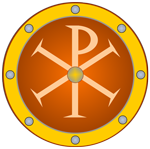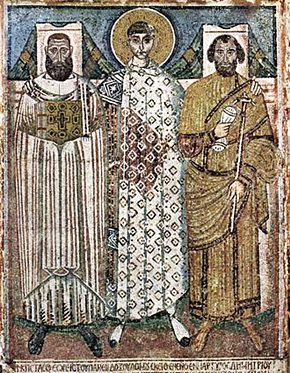
Siege of Thessalonica (IV) |
year: 676-678 |
| Unsuccessful siege of the city by the Slavs for two years | ★ ★ ★ ★ ★ |
|
enemy: Slavs
|
location: Modern Thessaloniki, Northern Greece
|
accuracy:
●●●●●
|
|
battle type: Siege |
war: Wars against Avars & Slavs |
modern country:
Greece |
| ▼ The Byzantines(emperor: Constantine IV) | ▼ The Enemies | |
| Commander: | Unknown | Unknown |
| Forces: | ||
| Losses: |
| Background story: |
| Since the 580s, the Slavs began their movement in the Southern Balkans. It was an event that went down in history as the Descent of the Slavs.
Thrace and Macedonia, but to a large extent the rest of Greece were deserted by the raids. One of the few cities that had resisted was Thessaloniki. The Slavs besieged it several times without success. The last time was in 617 when they besieged the city with the Avars, but failed again. When the settlement of the Slavs was completed, and after the decline of the Avars who were their powerful allies, a relative peace was reached, but with the Slavs having consolidated their presence in many autonomous regions called Sklaveniae. Thessaloniki in the 7th century had become a Byzantine “island in the middle of a Slavic sea”, while it remained the most important and richest city in the Balkans. The period of peace and coexistence with the Slavs in Macedonia came to an end after an incident that changed the scene: The ruler of the Rhynchinoi Slavs Perboundos, who was in Thessaloniki, was arrested by the prefect of the city after allegations were made against him that he made plans to occupy the city. Perboundos was prisoned in Constantinople, where after two attempts to escape he was executed in 674. The execution angered the Slavic tribes of Macedonia. The main source about these events is the 2nd Book of Stories of the miracles of Agios Dimitrios (Miracula Sancti Demetrii –anonymous work around 680), which attributes the salvation of Thessaloniki exclusively to the intervention of the patron saint of the city, Agios Dimitrios. |
The Battle: |
 Mosaic from St. Demetrius in Thessalonica, depicting the saint with the city's bishop and the eparch In 676, the Slavic coalition blockaded Thessaloniki by land and raided its environs, with each tribe being assigned a specific area: the Strymonitai attacked from the east and north, the Rhynchinoi from the south, and the Sagoudatai from the west. Three or four raids were launched each day, both on land and at sea, for two years. The city could not expect any assistance from the emperor, because Constantinople was also under siege by the Arabs. The situation was made worse by the city's authorities, who were very bad in managing the supplies. The anonymous author of the Miracles is highly critical of the commercial and civic elites for their corruption and incompetence, which led to the rapid onset of famine inside the city. The situation became so bad that many Thessalonians defected to the besiegers in order to escape from the hardship inside the city. The Slavs did not sympathize, and sold them on as slaves to other Slavic tribes; and only after some of these slaves escaped, bringing word of their sufferings to Thessaloniki, did the defections cease. Some relief was provided by the arrival of a squadron of ten ships with supplies in the summer of 677. But, the sailors took advantage of the Thessalonians, and sold them the grain in high prices, while the authorities used them as manpower to seek out any hidden caches of grain in the city. The local council decided to send the ten vessels manned by the most brave citizens, to get food from the Belegezitai, who were living at the shores of the Pagasetic Gulf in Thessaly. Their absence was noted and the Slavs decided to exploit the opportunity. They asked the assistance of the Drougoubitai, a large tribe living northwest of Thessaloniki, who had the know-how of making siege engines. Thus reinforced, the Slavs launched their decisive attack on 25th July, 677. According to the book of the Miracles, Saint Demetrius made some of the Slavs to turn back and thus the force of the attack weakened. Moreover, the siege engines did not help much. For three days, from 25 until 27 July, the Slavs launched attacks on the walls but were repelled by the defenders, with the aid, always, of Saint Demetrius himself, who intervened numerous times. Most notably he is recorded as appearing on foot with a cudgel defending a small gate at a place called “Arktos” —an event which some modern commentators interpret as an indication that the Slavs had penetrated into the city. On the evening of the 27th, the Slavs abandoned the assault and withdrew, taking their dead with them, but abandoning the siege engines, which were taken by the Thessalonians into the city. A few days later, the expedition sent to Thessaly returned, laden with wheat and dried vegetables. Despite the failure of the assault and the successful replenishment of the city's food supply, the Slavs continued with their blockade and raids, but their pressure relaxed somewhat. Their attention now shifted to the sea, and launched raids against seaborne merchant traffic, using not only the customary primitive monoxyla (dugout canoes), but real ships, capable of sailing in the high seas. This lasted until the emperor Constantine IV, free from other concerns after the end of the siege of Constantinople, ordered his army to advance against the Slavs through Thrace. The Strymonitai (who were closer to the capital being around Strymon river) prepared their defense, guarding passes and calling upon other tribes for aid. But they were decisively defeated by the imperial troops. After that all the Slavs fled; even the settlements close to the city were abandoned, as the Slavs sought refuge towards the interior. The famished population of Thessaloniki took the opportunity of pillaging the nearby Slavic settlements for food. The emperor also sent a grain fleet under strong escort by warships, carrying 60,000 measures of wheat for the city, which was a testament of renewed ability of the Byzantine central government to intervene decisively in the Balkans after the Arab danger had passed. Following this, the Slavs requested peace negotiations. |
Aftermath: |
| This siege was the last serious problem that the Byzantines faced with the Slavs, who retained relative autonomy in their regions, but coexistence with Byzantium was normalized. Problems arose again during the Bulgarian wars when the Bulgarian tsars managed to take - as almost compatriots - a large part of the Slavs on their side. The result was that after the defeat of the Bulgarians, the Slavs in Greece suffered a kind of ethnic cleansing. |
|
|
